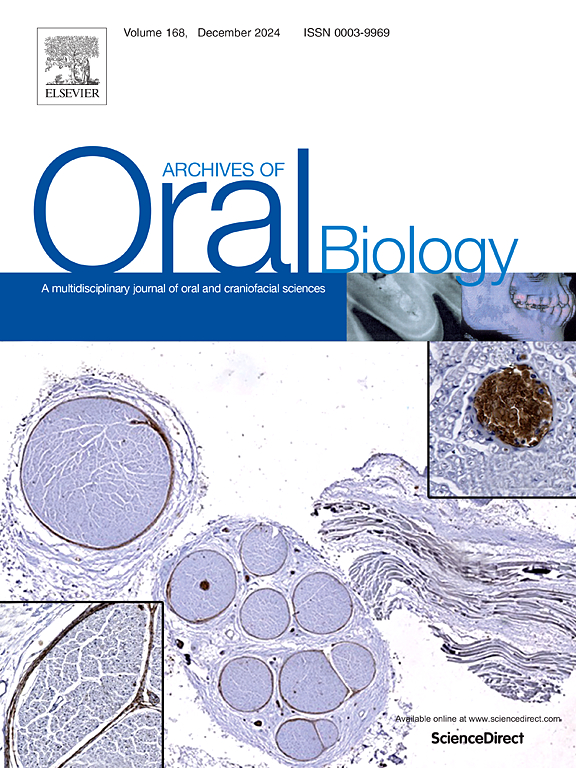牙本质发育不全、性别和牙型对成骨不全小鼠模型牙本质-牙釉质交界处组成和结构组织的影响
IF 2.1
4区 医学
Q2 DENTISTRY, ORAL SURGERY & MEDICINE
引用次数: 0
摘要
目的研究成骨不全小鼠牙本质-牙釉质交界处的结构和组成特征,重点探讨成骨不全、性别和牙型对牙本质的影响。由于磨牙和门牙具有不同的功能和生长模式,该研究采用多尺度方法,结合微型计算机断层扫描(micro-CT)、扫描电子显微镜(SEM)和拉曼光谱技术,比较了磨牙和门牙的牙本质-牙釉质连接。结果牙本质发育不全小鼠地膜牙本质宽度明显减小。雌性小鼠在矿物质含量和牙本质-牙釉质连接结构上的梯度明显大于雄性小鼠。磨牙的梯度宽度比门牙大。与门牙相比,磨牙具有更高的牙本质孔隙度和更小的牙本质覆盖宽度。结论牙本质发育不全导致牙本质发育不全小鼠小管直径减小,小管数量增加,这可能导致牙本质发育不全小鼠牙齿敏感性增高。女性可能对压力和骨折有更好的恢复能力,这可能解释了为什么牙本质发育不全在男性中更常见。由于磨牙的功能和机械应力不同,较大的梯度宽度可能有助于保护磨牙。本文章由计算机程序翻译,如有差异,请以英文原文为准。
Effects of dentinogenesis imperfecta, sex, and tooth type on the compositional and structural organization of the dentin-enamel junction in the osteogenesis imperfecta murine model
Objective
This study investigates the structural and compositional features of the dentin-enamel junction in the osteogenesis imperfecta murine teeth, focusing on the effects of dentinogenesis imperfecta, sex, and tooth type.
Design
The study compares dentin-enamel junctions in molars and incisors, as these teeth experience different functions and growth patterns, using a multiscale approach that combines micro-computed tomography (micro-CT), Scanning Electron Microscopy (SEM), and Raman Spectroscopy techniques.
Results
The width of the mantle dentin is significantly reduced in dentinogenesis imperfecta-affected mice. Female mice show significantly larger gradients in mineral content and structural dentin-enamel junction than male mice. Molars have larger gradient widths compared to incisors. Molars exhibit higher dentin porosity and a smaller mantle dentin width compared to incisors.
Conclusion
Dentinogenesis imperfecta causes a decrease in tubule diameter and an increase in the number of tubules, which may contribute to heightened tooth sensitivity in dentinogenesis imperfecta-affected mice. Females may have better resilience to stress and fractures, potentially explaining why dentinogenesis imperfecta might be diagnosed more frequently in males. Larger gradient widths in molars may help protect them due to their different functions and mechanical stresses.
求助全文
通过发布文献求助,成功后即可免费获取论文全文。
去求助
来源期刊

Archives of oral biology
医学-牙科与口腔外科
CiteScore
5.10
自引率
3.30%
发文量
177
审稿时长
26 days
期刊介绍:
Archives of Oral Biology is an international journal which aims to publish papers of the highest scientific quality in the oral and craniofacial sciences. The journal is particularly interested in research which advances knowledge in the mechanisms of craniofacial development and disease, including:
Cell and molecular biology
Molecular genetics
Immunology
Pathogenesis
Cellular microbiology
Embryology
Syndromology
Forensic dentistry
 求助内容:
求助内容: 应助结果提醒方式:
应助结果提醒方式:


